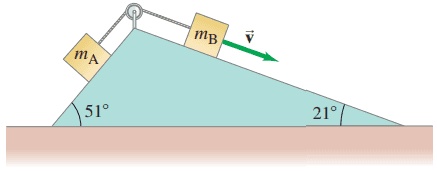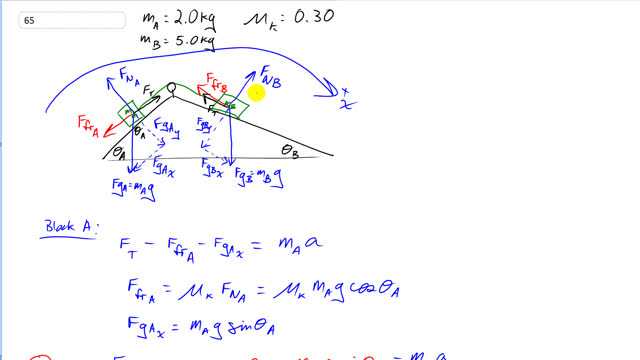
Two masses and are on inclines and are connected together by a string as shown in Fig. 4–61. The coefficient of kinetic friction between each mass and its incline is . If moves up, and moves down, determine their acceleration. [Ignore masses of the (frictionless) pulley and the cord.]


In order to watch this solution you need to have a subscription.
This is Giancoli Answers with Mr. Dychko. So, fasten your seat belt for this question, it's a good one, lots of algebra, you can really dig into the mathematics on this one. So, we're going to define the positive x direction to be the direction of motion of the block. So, in the case of this block A, positive is going to be up the ramp. And in case with block B positive is going to be down the ramp. So, they're both to the right-ish. OK. There are 4 forces acting on each block. So, consider block A, we have the force of friction acting against the direction of motion because we're told that it's initially going, block A is going upwards. And then in block B is going down like this. So, that means the kinetic friction being that it's always in the opposite direction to the direction of motion, is going to be pointing down the ramp for block A. And we have a tension force due to the string, connecting it to block B, pulling it up the ramp. We have a gravity going straight down and a normal force perpendicular to the ramp. And all of these forces have a subscript capital A to label them as belonging to block A. And on block B, it's the same four forces except that the force of friction is going up the ramp now and opposing gravity. Whereas for block A, friction and gravity are going in the same direction. So, that's one difference to notice between these two free body diagrams. Otherwise it's the same idea, you have gravity straight down, mass B times g, and you have a normal force and you have this tension as well to the string connecting it to block A. So, we have theta A and theta B, these angles in this composite ramp you might call it. We are going to find the acceleration of the system. And first we'll consider all the forces on block A and we're doing Newton's second law on block A, and then we'll do Newton's second law on block B, and then we'll have two equations and only two things that we don't know, and that is a recipe for getting an answer, if you have two equations and two unknowns, you can solve for either of the unknowns. Likewise if you have 3 things you don't know, you can need 3 equations and so on, that's the system of equations idea from mathematics. So, we'll start with block A. Newton's second law says the tension force which is positive because it's going in the up the ramp and that's going in the direction of motion which we have defined is positive here. And then minus the force of friction on block A. And then minus the component of gravity in the x direction of block A. That total force in the x direction is going to be equal to the mass of A times this acceleration. And notice I intentionally did not put a subscript on the acceleration because the acceleration for block A and the acceleration for block B will be the same, they're both going to be in the positive direction. And they're going to be equal magnitudes because these are connected by a string here. So, one's pulling the other. So, they're gonna have the same acceleration. So, it's intentional to just have the letter a there with no subscript A. And we can make substitutions into each, you know, each of these two terms here. We'll, first say that the friction force on block A is coefficient of kinetic friction times the normal force on block A, but the normal force on block A has to be equal to the component of gravity perpendicular to the plane of the ramp. And that's mg times cos theta A and where mass, of course, is mass of block A. And then the component of gravity in the x direction is ma g times sine theta A because this is the opposite leg of this triangle and so use sine to get the opposite leg multiplied by the hypotenuse, ma g. OK. And then we'll substitute for each of those in Newton's second law. So, we have force of friction is muK ma g cos theta A, written here. And then we have an expression for FgAx force of gravity on block A in the x direction is ma g sine theta A. So, they write that here. And then copy the tension force and then copy the ma times acceleration. And that's as far as we can go with block A. We've a single equation with two unknowns. We don't know tension force and we don't know acceleration, we know everything else here, though. So, since there are two unknowns, it means we need to search for another equation and block B is going to give it to us. So, here's Newton's second law for block B we have the component of gravity in the x direction is the only force in the positive direction here for all on the x axis. And then we have minus the tension force going up the ramp and minus the friction force opposing its velocity. And the friction force is going up the ramp. And so, and that equals mass of B times its acceleration, and its acceleration is the same as block A. So, there's no subscript on that acceleration. So, FgBx is mBg sine theta B. So, it's this gravity times the sine of theta B because this is the opposite leg of this gravity triangle here. And the friction force on block B is muK F NB. And the normal force on block B is the force of gravity times cos theta B because this normal force has to equal the component of gravity perpendicular to the ramp, and that's the adjacent leg of this gravity triangle. Alrighty. And the same idea as before, we make substitutions now into Newton's second law for block B so, we have FgBx is mBg sine theta B. And then copy the tension force here. And then we have friction force on block B is muK mBg cos theta B. And so, that's what's written there. Equals mass b times its acceleration. OK. And now it's a mathematics question. How do we solve for a? Well, it turns out that we have a handy coincidence that the tension force has opposite signs in equation 1 and equation 2. And so, we can add these equations which means add all the terms on the left side together and add all the terms on the right hand side together and it'll turn out that the tension force is, having opposite signs will make 0 and they'll just disappear. So, I'm going to just copy all the terms from the left side of both equations and write them out here and then copy the terms from the right hand side and add them together. And I'm not going to write down the tension force because they have opposite signs and they cancel each other out. So, we have negative muK ma g cos theta A, that's written here. And then minus ma g sine theta A. And plus mBg sine theta B minus muK mBg cos theta B and that's the left hand sides combined. And then we'll combine the right hand sides mass A times acceleration plus mass B times acceleration, is written here. So, I've added equation 1 and equation 2. And what we end up with is an equation with only one unknown, there's a lot of stuff there but there's only one thing we don't know which is little a. So, let's solve for a. I'm going to switch the sides around so the unknown acceleration is on the left, and then factor it out. So, we have a times mass A plus mass B. And then we have equals... g is a common factor here, so, we'll factor that out. And then we'll factor out this negative ma from these two terms. And so we have negative ma times bracket muK cos theta A plus sine theta A. And so, that's a plus there, and that's positive 2 because we factored out a negative ma. And then we have plus and B factored out from these two terms sine theta B minus muK cos theta B. And all of that gets divided by ma plus mB. And we substitute in some numbers. 9.8 meters per second squared times negative 2 kilograms times 0.3 times cos 51 plus sine 51, and then in bracket, plus 5 kilograms times sine 21 minus 0.3 times cos 21, and then all divided by 7 kilograms. And if you want to see what that looks like on a calculator, I'll show you. You have to be careful when you're punching this into heavier brackets match. And if you really want to be methodical about it, you can count the number of open brackets and count the number of closed brackets and they should be the same if you've done your bracket matching correctly. So, for every open bracket there should be a closed bracket. So, we have 1, 2, 3, 4, 5, 6, 7, open brackets on the numerator. And so we should have 7 closed brackets in denominator before we do division. So, let's count them. We have 1, 2 and 3 and 4, 5, 6. Whoops. No, that's not right. So, there should be 7. 1, 2, 3, yeah, I think I missed one there. 4, 5, 6, 7. So, it is correct. There are 7 closed brackets. 7 open brackets, 7 closed brackets. Divided by 2 plus 5 which is 7. And that gives negative 2.2 meters per second squared is the acceleration. So, when these blocks are moving, block A is moving up and to the right, and block B is moving down to the right. When that's happening, this system is slowing down and the acceleration is opposing the initially positive velocity, that's what this negative sign means. And so, it's eventually gonna... Well, either turn around and move the other way
how is Fgax= fg sintheta shouldn't it be = to fg costheta